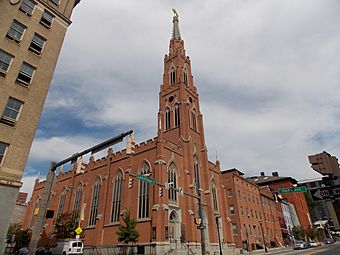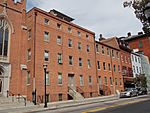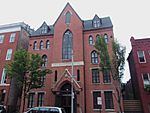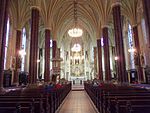National Shrine of St. Alphonsus Liguori facts for kids
Quick facts for kids |
|
|
St. Alphonsus' Church, Rectory, Convent and Halle
|
|

St. Alphonsus Church and Rectory, September, 2014
|
|
| Location | 112-116, 125-127 W. Saratoga Street Baltimore, Maryland |
|---|---|
| Area | 6 acres (2.4 ha) |
| Built | 1842 |
| Architect | Robert Cary Long Jr. |
| Architectural style | Gothic Revival |
| NRHP reference No. | 73002195 |
| Added to NRHP | May 23, 1973 |
The National Shrine of St. Alphonsus Liguori is a historic Catholic church in Baltimore, Maryland. It is also known as the St. John Neumann Shrine. People sometimes call it "Baltimore's Powerhouse of Prayer."
This church complex was started by a group called the Redemptorists. It has connections to many important people in Baltimore's Catholic past. Since 1992, special church services called Tridentine Masses have been held there regularly. Today, a group of priests called the Priestly Fraternity of Saint Peter manages the church. The entire complex was added to the National Register of Historic Places in 1973.
About the Church Buildings
The design of St. Alphonsus Church was inspired by St. Stephen's Cathedral in Vienna. It is built in a style called basilica. The church is made of red brick with special limestone decorations. It is built in the Gothic Revival style.
The main part of the church, called the nave, is 50 feet (about 15 meters) tall. A fancy steeple rises 210 feet (about 64 meters) above a three-level bell tower. A 12-foot (about 3.7 meters) gold cross sits at the very top of the steeple.
The Halle is a 4.5-story brick building. It is also in the Gothic Revival style and is across the street from the church. It has a main entrance in a square section that sticks out. The nearby three-story convent and four-story rectory are simpler brick buildings. They are built in the Georgian style.
History and Important People
The church complex was built between 1842 and 1845. It was the first big project designed by a Baltimore architect named Robert Cary Long Jr.. From its beginning until 1917, the church was managed by the Redemptorist Fathers. These priests came to Baltimore to help the growing German immigrant community.
John Neumann was one of the early pastors, or leaders, of St. Alphonsus. He later became a bishop in Philadelphia in 1852. He was recognized as a saint on June 19, 1977. John Neumann's assistant pastor, Francis Xavier Seelos, became pastor after him. Seelos later worked in many different areas, from Connecticut to Illinois and New Orleans. He was recognized as "blessed" on April 9, 2000.
By 1917, many of the German immigrants had moved away from the area. St. Alphonsus then became a church for the Lithuanian immigrant community. The St. Alphonsus Church, Rectory, Convent, and Halle complex was officially listed on the National Register of Historic Places in 1973.
Since 1992, a traditional form of Catholic service, the Tridentine Mass, has been offered regularly at St. Alphonsus. Since 2017, the church has been managed by the Priestly Fraternity of Saint Peter (FSSP). It is still officially part of the Archdiocese of Baltimore.
Images for kids







